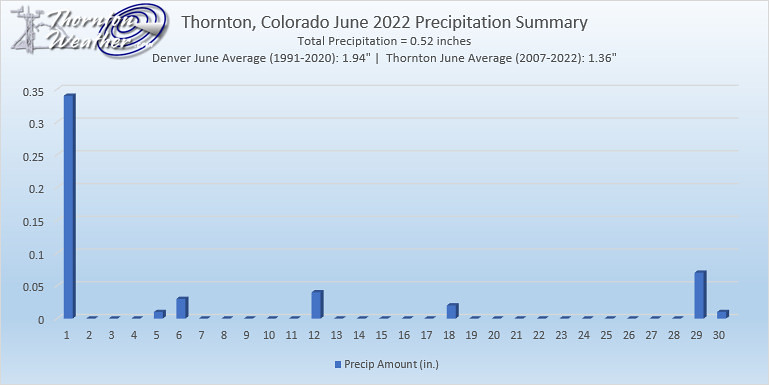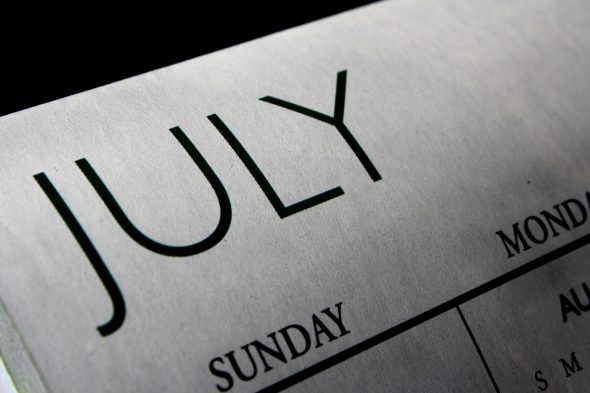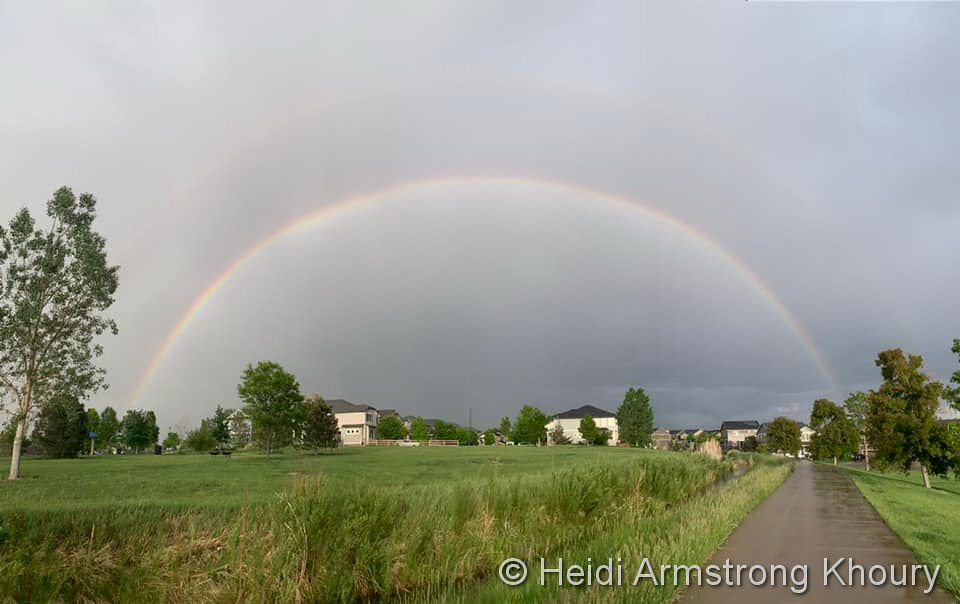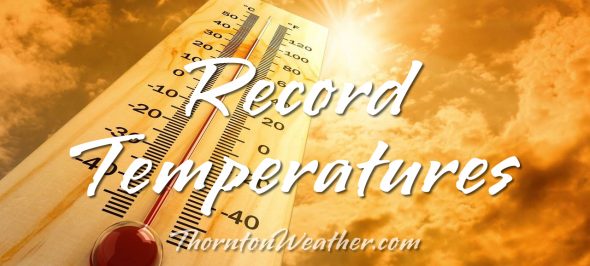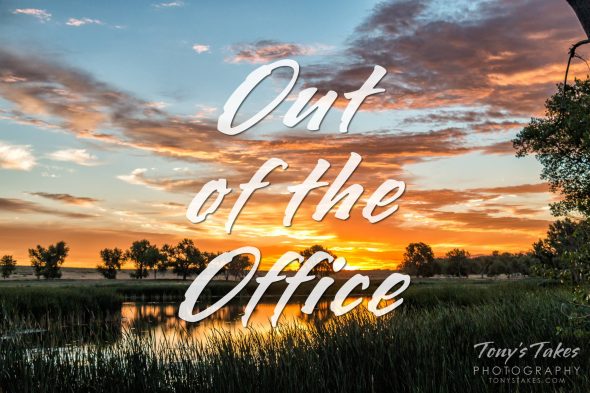
The first half of June is when Colorado’s severe weather season really kicks into high gear and our look back at this week in Denver weather history reflects that. Numerous flooding, hail, and tornadic events punctuate just how dangerous and damaging our weather can be this time of year.
From the National Weather Service:
11-14
In 1999…damage from several hailstorms in and near metro Denver totaled 35 million dollars. About 17.5 million dollars was from automobile claims with another 17.5 million in homeowner claims. The areas hardest hit by the storms included Castle Rock…Commerce City…Evergreen… And Golden.
12
In 1901…south winds were sustained to 45 mph with an extreme velocity to 47 mph.
In 1917…northwest winds were sustained to 40 mph with gusts to 45 mph.
In 1927…flooding on Little Dry Creek in Englewood resulted in two deaths.
In 1947…a trace of snow fell over downtown Denver during the early morning. This was the latest last snow of the season (trace or more). This also marked the end of the longest snow season…264 days…from the first snow…a trace…on September 22…1946. High temperature of 43 degrees was a record low maximum for the date. Minimum temperature of 33 degrees was a record low for the date.
In 1971…a funnel cloud sighted over Arvada possibly touched down at the base of the foothills. The public reported 3/4 inch to 1 inch diameter hail over the city of Denver.
In 1974…strong thunderstorm winds caused damage to power lines in metro Denver. Northwest winds gusted to 45 mph at Stapleton International Airport.
In 1975…a thunderstorm wind gust to 56 mph was recorded at Stapleton International Airport.
In 1982…three small tornadoes were sighted near Bennett. One of the twisters caused minor crop and road damage along its path. A brief tornado was sighted by national weather service observers at Stapleton International Airport.
In 1983…3/4 inch hail fell in Boulder. Golf ball to 3/4 inch size hail fell in Arvada…denting cars and house roofs. Over a thousand hail damage insurance claims were filed from the area. Golf ball size hail also fell in Northglenn and Bennett…1 to 2 inch hail in Thornton…2 1/2 inch hail in northeast of Denver. A tornado was sighted 10 miles northeast of Stapleton International Airport; it was only on the ground for 1 to 2 minutes.
In 1984…large hail pelted many parts of southern metro Denver. Fifteen aircraft were damaged by golf ball size hail at Centennial airport. Golf ball size hail was reported in south Denver…and 3/4 inch hail was measured in southeast Aurora.
In 1987…a small weak tornado touched down for about 3 minutes near the intersection of I-70 and Colorado Blvd in northeast Denver. No damage was recorded. A microburst wind gust to 53 mph was recorded at Stapleton International Airport.
In 1991…in the city of Denver…lightning struck a tree under which seven people were picnicking. One person was critically injured. The others received only minor injuries.
In 1992…golf ball size hail fell in Evergreen.
In 1994…microburst winds gusting to 53 mph kicked up some blowing dust at Stapleton International Airport.
In 1996…lightning struck a house in Parker…which sparked a fire. The bolt was strong enough to blow nails out of the drywall in one room. About 85 percent of the house was damaged. No dollar estimate of the damage was available. Lightning also struck a power line in Boulder…which left 250 customers without electricity for a short time.
In 1997…a tornado touched down near Parker…damaging some construction equipment. Hail to 2 inches in diameter was measured in Henderson. One inch diameter hail fell in the city of Denver with 3/4 inch hail measured in Lakewood.
In 1999…hail as large as 1 1/2 inches in diameter struck Hudson. A funnel cloud was sighted by ramp personnel to the east of Denver International Airport.
In 2003…lightning blew a hole in the roof of a house in Highlands Ranch. The bolt knocked several holes in the bedroom ceiling and damaged the home’s electrical system.
In 2004…lightning struck a home in Louisville…but caused only minor damage.
In 2006…a strong microburst wind gust…estimated at 69 mph… Ripped the roof off a horse barn near the intersection of Havana Street and Smith Road in Denver. A 13 year old girl was injured…when she was thrown from a horse inside the barn at the time the roof was being torn off. A thunderstorm produced a microburst wind gust to 54 mph and a trace of rainfall at Denver International Airport. A severe thunderstorm produced hail to 0.75 inch near Watkins.
12-17
In 2000…two large wildfires developed in the Front Range foothills as careless campers and very dry conditions proved to be a dangerous combination. Strong winds gusting in excess of 60 mph on the 13th fanned the flames… Spreading both wildfires out of control. Winds gusted to 78 mph atop Niwot Ridge near the Continental Divide west of Boulder. The Hi Meadows wildfire…about 35 miles southwest of Denver…consumed nearly 11 thousand acres and 80 structures…mostly high priced homes. The Bobcat wildfire…located about 12 miles southwest of Fort Collins… Consumed nearly 11 thousand acres and 22 structures. Late on the 16th…a strong cold front moved south over the great plains into northeastern Colorado. Low level upslope conditions developed in the wake of the front…producing 2 to 4 inches of snowfall overnight at elevations above 8 thousand feet. Firefighters were able to contain both fires shortly thereafter.
13
In 1956…a microburst caused a brief wind gust to 59 mph at Stapleton Airport.
In 1957…an unconfirmed tornado appeared to touch the ground in the vicinity of Franktown. No damage was reported from the twister.
In 1968…a violent gust of wind…possibly associated with a thunderstorm…caused 75 hundred dollars damage in Boulder.
In 1973…hail…1/2 to 3/4 inch in diameter…fell over Lakewood. Flash flooding occurred in west Denver from the same storm.
In 1974…a thunderstorm wind gust to 64 mph was recorded at Stapleton International Airport.
In 1977…hail the size of table tennis balls…1 1/2 inches in diameter…was reported in Boulder.
In 1981…large hail to golf ball size fell in Denver… Northglenn…and Brighton. Hail as large as baseballs was reported in federal heights.
In 1984…one of the worst hailstorms ever experienced in metro Denver struck the northwestern suburbs of Arvada…Wheat Ridge…and Lakewood…but large hail also fell in Golden… Southeast Denver…and Aurora. Homes and other buildings sustained around 200 million dollars in damage. Thousands of cars were battered by giant hailstones…and total damage to vehicles was estimated at 150 million dollars. In some areas…golf ball size hail fell continuously for 30 to 40 minutes. Some places were pelted with a few stones as large as grapefruits! Roofs on thousands of structures were severely damaged. Uncounted car windshields were broken; two-thirds of Arvada’s police cars were rendered inoperable. Torrential rains…with as much as 4.75 inches in Lakewood clogged drains and caused widespread damage from flooding. In some places hail was washed into drifts several feet deep. About 20 people were injured by the giant hailstones. One couple was hospitalized. A woman drowned when she was trapped under a trailer by high water. Only pea size hail fell at Stapleton International Airport.
In 1988…2 inch hail fell in Parker. Soft hail 1 inch in diameter fell at the mouth of turkey creek canyon 5 miles southeast of Morrison. Hail between 1 inch and 1 3/4 inches fell at both Bennett and Strasburg. A tornado touched down briefly at Strasburg. A brief funnel cloud was sighted by national weather service observers 15 miles southwest of Stapleton International Airport.
In 1991…a Boulder man was injured when struck by lightning while in a tent. He received only minor burns.
In 1997…lightning struck a home in Denver. The extent of the damage was unknown. A home in Littleton was also struck. The house caught fire…but the extent of the damage was not known.
In 1998…a strong mountain wave produced a brief period of high winds along the Front Range. A small building atop squaw pass west of Denver was blown down. Tree limbs were downed across metro Denver. Peak wind gusts included: 80 mph on Squaw Pass…69 mph at Jefferson County Airport near Broomfield…and 60 mph in Westminster and at the National Center for Atmospheric Research in Boulder. West-northwest winds gusted to 51 mph at Denver International Airport.
In 2001…high winds developed briefly in Boulder County. A peak wind gust to 76 mph was recorded at the National Center for Atmospheric Research atop the mesa in Boulder. A wind gust to 72 mph was recorded at southern hills middle school in Boulder. Lightning started a small fire…which damaged the roof of a house in Greenwood Village.
In 2009…severe thunderstorms produced hail up to one inch in diameter near Arvada and byers…as well as 7 miles north-northwest of Front Range airport near watkins.
13-14
In 2006…the high temperature of 99 degrees on the 13th equaled the record maximum temperature for the date first set in 1994. The high temperature of 102 degrees on the 14th was a new record maximum temperature for the date.
14
In 1877…an evening thunderstorm produced lightning which struck several houses and killed a cow in the bottom land of the South Platte River
In 1886…hail as large as 3/4 inch in diameter fell in the city. Precipitation was only 0.10 inch.
In 1887…south winds were sustained to 41 mph.
In 1900…a thunderstorm produced northwest winds to 51 mph with gusts to 61 mph…but only a trace of rain.
In 1923…a severe thunderstorm pelted the city with hail. The stones ranged in diameter from 0.2 to 0.8 inch. Gardens and greenhouses suffered considerable damage. Rainfall was only 0.14 inch downtown.
In 1960…one workman was killed and 4 others injured in Lakewood when a partly built apartment building collapsed in strong winds. Microburst wind gusts to 54 mph caused some blowing dust at Stapleton Airport.
In 1967…tornadoes touched down briefly 3 miles west of Franktown and 4 miles northeast of Parker. No damage was reported. Numerous funnel clouds were reported over south metro Denver…one 5 miles south of Denver…one 2 to 3 miles north of Castle Rock…and two near Littleton.
In 1968…a microburst wind gust to 52 mph was recorded at Stapleton International Airport.
In 1972…1 3/4 inch hail was reported in Wheat Ridge.
In 1976…high winds…unusually strong for this late in the season…raked metro Denver. Wind gusts estimated to 100 mph tore 24 boats from their moorings and damaged a total of 47 boats at Boulder reservoir. Wind gusts to 82 mph were recorded in Boulder. The strong winds toppled the wind mast at a radio station in Boulder. An automobile was smashed by a fallen tree in Boulder. Other damage in Boulder was minor…but power outages occurred when tree limbs fell on power lines. At Jefferson County Airport near Broomfield…wind gusts to 78 mph were recorded with 87 mph gusts clocked at Rocky Flats nuclear plant south of Boulder. Wind gusts to 66 mph were observed in Littleton… And northwest winds gusted to 46 mph at Stapleton International Airport. The strong winds collapsed a barn near Arvada. Several horses received minor injuries. Thirty trees were uprooted or broken in Denver. Four major power outages occurred from west Denver and Lakewood to the foothills.
In 1982…the worst hailstorm in 17 years struck Commerce City. The storm left 4 to 8 inches of hail on the ground. A few of the stones were as large as golf balls. Many vehicles were dented…and some windshields were shattered. Roofs of homes were damaged. Total damage was estimated at over one million dollars. Hail to 1 inch in diameter also fell in Littleton. Only 1/4 inch hail was measured at Stapleton International Airport.
In 1988…lightning ripped a small hole in the roof of a home in the southern part of Boulder. There were some power outages in the area.
In 1992…an off duty national weather service employee reported hail to 1 inch diameter in Westminster.
In 1997…one inch diameter hail fell in Bennett…and 3/4 inch hail was measured in Littleton.
In 1999…hail as large as 1 1/2 inches in diameter hit Aurora. Lightning sparked two small fires at separate residences near the Hiwan Country Club in Evergreen.
In 2004…lightning sparked two small fires near Jamestown. One was in Geer Canyon and the other 7.5 miles up Sunshine Canyon. Both were quickly contained and caused no damage to structures in the area.
In 2009…a complex of severe thunderstorm produced large hail damaging thunderstorm and funnel clouds across parts of the urban corridor. The line formed along a boundary over the western suburbs of Denver then moved east. The boundary produced at least one well defined funnel cloud that could be observed by stadium full of baseball fans at Coors Field. Large hail…up to 1 3/4 inches in diameter…was reported in Arvada…Broomfield…Denver…Federal Heights and Northglenn. In addition…the storm produced peak wind gusts from 60 to 74 mph. At Denver International Airport…a peak wind gust to 58 mph was observed from the west-northwest.
In 2014…severe thunderstorms broke out across the Urban corridor. Large hail…ranging in size from 1 to 2 inches in diameter…was observed. The area extended from around Englewood to Aurora and included: Brookridge…Cherry Knolls… Greenwood Village and south Denver. As many as 212 thousand residences were potentially impacted by the storms. The hail shattered windshields and damaged vehicles.
15
In 1907…south winds were sustained to 40 mph. The winds were strong all day.
In 1908…the hail storm was unusually severe. Heavy clouds moved over the city from the north and northwest…and by late morning the weather had become very threatening. Heavy rain with intermittent hail from pea to 3/4 inch in diameter fell near noon. The fall of rain and hail totaled 0.68 inch of precipitation with 0.35 inch in just 5 minutes. The temperature fell from 71 degrees to 51 degrees during the storm. The hail did considerable damage to trees…gardens…and hot houses. On sidewalks with northern exposures…the hail ranged in depth from 2 to 6 inches. West winds were sustained to 29 mph during the storm.
In 1956…strong southeast winds raked metro Denver all day. Sustained winds at 44 mph with gusts as high as 61 mph were recorded at Stapleton Airport where blowing dust briefly reduced the visibility to 2 miles.
In 1984…golf ball size hail pelted southern and central Aurora. Rainfall of 2.06 inches over central Aurora in just over an hour produced local street flooding.
In 1987…golf ball size hail fell in the southern part of Lakewood.
In 1988…several tornadoes developed across metro Denver. One tornado touched down just northeast of the rocky mountain arsenal. The twister moved very slowly and did no damage…except to demolish a small electrical substation… Even though it was on the ground for nearly 30 minutes. Later…another tornado was sighted east of Brighton about 2 miles north of barr lake. An f2 tornado cut a swath through northeast Denver. The main path went through a thickly wooded area for about 6 blocks and uprooted about 500 city owned trees…many of them large elms 75 to 100 years old. Hundreds of privately owned trees were also sucked from the ground by the slow moving twister…which was filmed by a news team in a helicopter as it uprooted trees. The replacement cost to the city owned trees was estimated at 1.5 million dollars. The twister did little damage to buildings. Some homes suffered roof and chimney damage…a gas main was ruptured…and some cars were damaged by falling trees. The uprooted trees also caused curb and sidewalk damage and cut some electrical wires. The funnel cloud passed close to Stapleton International Airport. Aircraft operations were shut down…and the tower was evacuated. The tornado was on the ground for almost 25 minutes. An F3 tornado cut an erratic path through south Denver for about 25 minutes…causing extensive damage in at least 3 areas. The twister damaged about 85 buildings… 20 severely; the total loss was estimated at 5 to 10 million dollars. Many cars were severely damaged; at least 15 vehicles were overturned. One trailer was lifted onto the top of a building that had just been unroofed; numerous antique cars inside the building were damaged. A ford bronco was blown over a church…and landed 100 yards away. A metal storage shed was deposited far above the ground in some power lines. The tornado uprooted many trees on a golf course. No one was seriously hurt…although seven people suffered minor injuries from flying debris. A golfer was thrown 40 feet…but was not hurt; a man clinging to a telephone pole was unscathed…but lost both shoes…a sock…and buttons off his shirt. A woman holding a baby was sucked through a broken convenience store window… But was unhurt. A dog…tethered to the ground by its leash… Was suspended in the air by the twister. Uprooted trees crushed cars and damaged curbs and sidewalks. People in downtown Denver could see three tornadoes occurring simultaneously. Hail as large as 1 3/8 inches in diameter fell in extreme southeast Aurora.
In 1997…a tornado touched down briefly at the Colorado National Speedway near Dacono north of Denver. The tornado ripped through the south grandstand causing at least 50 thousand dollars in damage to a shed…kiosk… Bleachers…and several concession stands.
In 2004…a tornado touched down briefly near Castle Rock and blew the roof off a machine shop. A tornado near Elizabeth destroyed a barn and caused roof damage to a home. Two other barns on nearby properties were damaged extensively. The twister also caused widespread tree damage in the area. A tornado also touched down near Bennett and Strasburg…but did no damage.
In 2009…thunderstorm winds knocked a tree on to two vehicles in Boulder. One of the drivers was injured when the tree smashed into the windshield of her car.
Continue reading June 12 to June 18: This week in Denver weather history →

